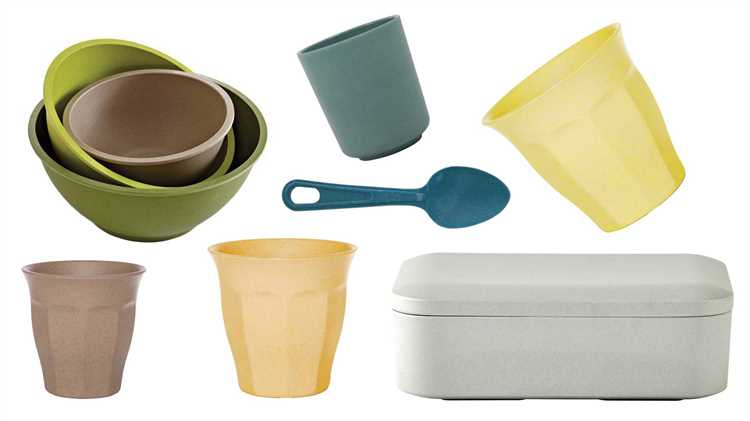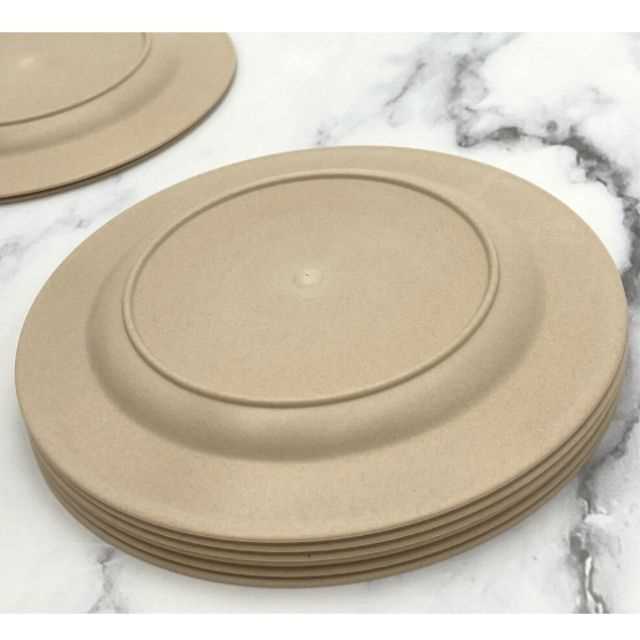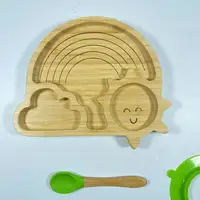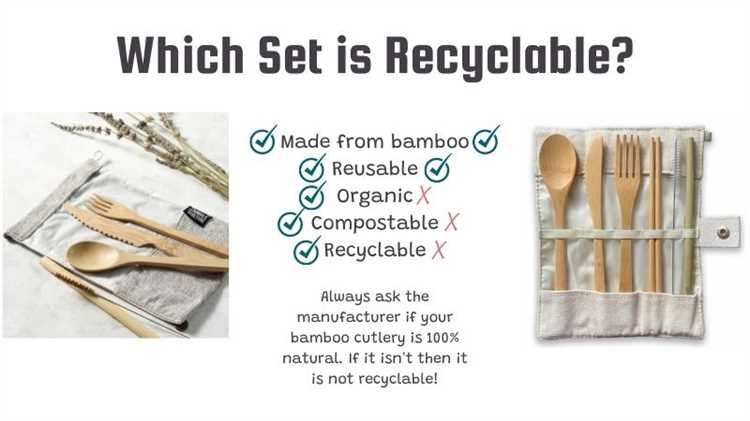
Are you searching for eco-friendly alternatives to traditional disposable plates? Look no further than bamboo plates! These plates are not only stylish and durable, but they are also an excellent choice for the environment. However, once you are done using your bamboo plates, it’s essential to understand how to properly recycle them.
Why should you recycle bamboo plates?
Unlike plastic or paper plates, bamboo plates are made from a renewable and sustainable resource. Bamboo is a fast-growing grass that requires no pesticides or fertilizers for cultivation, making it an eco-friendly choice. By recycling bamboo plates, you can help reduce overall waste and contribute to a more sustainable future.
How can you recycle bamboo plates?
When it comes to recycling bamboo plates, the process is relatively simple. First, make sure the plates are clean and free from any food residue. Next, check with your local recycling center to determine if they accept bamboo products. If they do, you can place the plates in your regular recycling bin or follow any specific guidelines provided by the recycling facility.
If your local recycling center does not accept bamboo products, don’t worry! There are other options available. You can try composting the bamboo plates if they are labeled as compostable. Additionally, you can repurpose them for various arts and crafts projects or donate them to local schools, community centers, or animal shelters where they can be used as food serving dishes.
Conclusion
Recycling bamboo plates is an important step we can all take to reduce waste and promote sustainability. By choosing bamboo plates over traditional disposable options, you are making a conscious choice to protect the environment. Remember to follow proper recycling guidelines and explore alternative options if your local recycling center does not accept bamboo. Together, we can make a positive impact on our planet!
- Why Choose Bamboo Plates?
- Environmental Benefits of Bamboo Plates
- 1. Renewable Resource
- 2. Minimal Carbon Footprint
- 3. Biodegradable and Compostable
- 4. Chemical-Free Production
- Durability and Versatility of Bamboo Plates
- Durable Construction
- Versatile Design
- How to Properly Dispose of Bamboo Plates
- 1. Rinse and Clean
- 2. Check Local Recycling Guidelines
- 3. Composting Option
- Compostability of Bamboo Plates
- Benefits of composting bamboo plates:
- How to compost bamboo plates:
- Recycling Options for Bamboo Plates
- Tips for Recycling Bamboo Plates
- 1. Clean the plates
- 2. Remove any non-bamboo components
- 3. Check local recycling guidelines
- 4. Separate from other materials
- 5. Consider composting
- Cleaning and Preparing Bamboo Plates for Recycling
- 1. Remove any food residue
- 2. Wash the plates
- 3. Let them air dry
- 4. Check for any damages
- Q&A:
- Can bamboo plates be recycled?
- What is the process of recycling bamboo plates?
- Are bamboo plates biodegradable?
- Is recycling bamboo plates more environmentally-friendly than using disposable plastic plates?
- Can I recycle bamboo plates in my regular recycling bin?
- Can I recycle bamboo plates?
- How are bamboo plates recycled?
Why Choose Bamboo Plates?
When it comes to selecting the right type of plates for your kitchen or event, bamboo plates are an excellent choice. Here are some reasons why:
1. Sustainable: Bamboo is one of the most sustainable materials on the planet. It is a renewable resource that grows quickly, requiring no replanting and minimal water and pesticides.
2. Biodegradable: Unlike plastic plates, bamboo plates are fully biodegradable. They break down naturally over time without causing harm to the environment.
3. Durable: Bamboo plates are incredibly strong and sturdy, making them a reliable option for both everyday use and special occasions. They can withstand high temperatures and resist cracking or breaking.
4. Lightweight: Despite their durability, bamboo plates are lightweight and easy to handle. This makes them suitable for outdoor events, picnics, and camping trips.
5. Natural and Chemical-Free: Bamboo is a natural material that does not require the use of harmful chemicals or pesticides during its production. This means that bamboo plates are safe to use and do not leach any toxins into your food.
6. Versatile: Bamboo plates come in various sizes, shapes, and designs, allowing you to choose the perfect option for your needs. Whether you prefer a sleek and minimalistic style or a more vibrant and decorative plate, there is a bamboo option for everyone.
7. Easy to Clean: Bamboo plates are non-porous and resistant to stains, making them easy to clean. They can be washed by hand or in a dishwasher without any issues.
Overall, bamboo plates are an eco-friendly, durable, and versatile alternative to traditional plates. By choosing bamboo, you can make a positive impact on the environment without compromising on style or functionality.
Environmental Benefits of Bamboo Plates
Bamboo plates offer several environmental benefits compared to traditional disposable plates. Here are some of the key advantages:
1. Renewable Resource
Bamboo is a highly renewable resource, known for its fast growth rate. It can be harvested within 3-5 years, while other trees take decades to reach maturity. This makes bamboo an ideal choice for sustainable and eco-friendly plate production.
2. Minimal Carbon Footprint
Bamboo has a minimal carbon footprint compared to other materials used for disposable plates. It absorbs large amounts of carbon dioxide and releases a higher amount of oxygen into the atmosphere. This makes it a great option for reducing greenhouse gas emissions.
3. Biodegradable and Compostable
Bamboo plates are biodegradable and compostable, meaning they can naturally decompose over time without leaving harmful residues. They break down into organic matter, helping to enrich the soil and reducing the amount of waste sent to landfills.
4. Chemical-Free Production
The production of bamboo plates does not involve the use of harmful chemicals or pesticides. Bamboo is naturally pest-resistant, reducing the need for chemical treatments. This ensures that bamboo plates are safe for both human consumption and the environment.
| Advantages |
|---|
| Renewable Resource |
| Minimal Carbon Footprint |
| Biodegradable and Compostable |
| Chemical-Free Production |
Durability and Versatility of Bamboo Plates
When it comes to choosing a sustainable and eco-friendly alternative to traditional plastic plates, bamboo plates are an excellent option. Bamboo is a durable material that can withstand everyday use without easily breaking or cracking.
One of the key benefits of bamboo plates is their versatility. They come in a variety of shapes and sizes, making them suitable for different types of meals and occasions. Whether you’re serving a casual lunch or a formal dinner, you can find bamboo plates that meet your needs.
Durable Construction
Bamboo plates are constructed to be sturdy and long-lasting. They are designed to withstand heat, making them perfect for serving hot soups and meals. Their strong construction ensures that they do not easily warp or bend under the weight of heavy food items.
Additionally, bamboo plates are resistant to stains and odors, unlike some other eco-friendly alternatives. They are easy to clean and can be safely washed in the dishwasher. This durability means that bamboo plates can be used time and time again, reducing the need for single-use plastic plates.
Versatile Design

Bamboo plates come in a wide range of designs and finishes, catering to different preferences and styles. From simple and elegant to colorful and vibrant, there is a bamboo plate to suit every taste. They can be used for both casual and formal dining settings, making them a versatile choice for any occasion.
Furthermore, bamboo plates are lightweight and easy to handle, making them ideal for picnics, camping trips, or outdoor events. They are also stackable, allowing for convenient storage in kitchens or cabinets with limited space.
In conclusion, bamboo plates are not only eco-friendly but also durable and versatile. Their strong construction ensures they can withstand everyday use and be used repeatedly without easily breaking. With their wide range of designs, they can be used for a variety of meals and occasions. Choosing bamboo plates is a smart and sustainable choice that helps reduce plastic waste and promote a greener future.
How to Properly Dispose of Bamboo Plates
When it comes to sustainable practices, knowing how to properly dispose of bamboo plates is essential. Bamboo plates are an eco-friendly alternative to disposable paper or plastic plates, but they still require proper disposal to ensure they can be recycled correctly.
1. Rinse and Clean
Before disposing of your bamboo plates, make sure to rinse and clean them thoroughly. Remove any food particles or residue from the surface of the plates and wash them with warm water and mild dish soap. This step is important to prevent contamination of the recycling process.
2. Check Local Recycling Guidelines
Next, check your local recycling guidelines to see if bamboo plates are accepted in your recycling program. While bamboo is a biodegradable material, some recycling facilities may not be equipped to handle it. If bamboo plates cannot be recycled in your area, the best course of action is to dispose of them in your regular trash.
However, if your local recycling program does accept bamboo plates, follow the guidelines for recycling. This may include separating the plates from other recyclables and packaging them appropriately for collection.
3. Composting Option
If your area has a composting program, another option for disposing of bamboo plates is to compost them. Bamboo is a natural material that can decompose and contribute to the production of nutrient-rich compost. Check with your local compost facility to see if bamboo plates are accepted and any specific instructions for composting.
| Step | Description |
|---|---|
| Rinse and Clean | Thoroughly rinse and clean the bamboo plates to remove any food particles or residue. |
| Check Local Recycling Guidelines | Investigate whether your local recycling program accepts bamboo plates for recycling. |
| Composting Option | If available, consider composting the bamboo plates to contribute to nutrient-rich compost production. |
Remember, proper disposal of bamboo plates ensures that they can be recycled or composted correctly, reducing waste and environmental impact.
Compostability of Bamboo Plates
Bamboo plates are not only a sustainable alternative to traditional plates but also a compostable option. The compostability of bamboo plates makes them an excellent choice for environmentally conscious individuals.
When disposed of in a compost pile, bamboo plates break down naturally and return to the earth, without leaving behind any harmful chemicals or toxins. This process is known as composting, where organic materials are allowed to decompose and turn into nutrient-rich soil.
Bamboo plates are made from bamboo fiber, which is a natural material that is biodegradable and compostable. The fiber is extracted from the bamboo plant and then molded into the shape of plates. Unlike plastic or paper plates, bamboo plates do not release any harmful substances when they break down in the compost pile.
Benefits of composting bamboo plates:

- Reduces waste: When bamboo plates are composted instead of thrown away, they help reduce the amount of waste that ends up in landfills.
- Improves soil quality: Composting bamboo plates adds valuable nutrients to the soil, improving its fertility and overall health.
- Closes the loop: By composting bamboo plates, you are participating in a circular economy, where waste is turned into a valuable resource.
How to compost bamboo plates:
Composting bamboo plates is a straightforward process. Here are steps to follow:
- Remove any leftover food scraps or residues from the bamboo plates.
- Break the plates into smaller pieces to speed up the decomposition process.
- Add the broken bamboo plates to your compost pile or bin.
- Mix the bamboo plates with other compostable materials, such as vegetable scraps, leaves, and organic matter.
- Regularly turn or aerate the compost pile to promote decomposition.
- After a few months, the bamboo plates will have fully decomposed, and you can use the resulting compost to enrich your garden soil.
By composting bamboo plates, you can reduce waste, improve soil quality, and contribute to a more sustainable future.
Recycling Options for Bamboo Plates
When it comes to the disposal of bamboo plates, it’s important to consider recycling as an eco-friendly option. While bamboo plates are biodegradable and can break down naturally, recycling them is a great way to maximize their life cycle and reduce waste. Here are several recycling options for bamboo plates:
- Check with your local recycling center: Start by reaching out to your local recycling center to inquire about their specific guidelines for recycling bamboo plates. Some recycling centers may accept bamboo plates, while others may not. It’s important to know what options are available in your area.
- Compost the plates: If your local recycling center does not accept bamboo plates, you can consider composting them. Bamboo plates are compostable and will break down easily in a composting facility. Make sure to remove any non-compostable elements such as stickers or plastic coatings before putting them in the compost.
- Reuse the plates: Another option is to reuse the bamboo plates instead of throwing them away. If the plates are still in good condition, you can wash them and use them for multiple purposes. They can be used for picnics, parties, or even as decorative items.
- Repurpose the plates: If the bamboo plates are no longer suitable for their original purpose, get creative and repurpose them. They could be used as plant saucers, holders for small items, or even as art materials for crafting projects.
- Donate the plates: If your bamboo plates are still in good condition but you no longer have a use for them, consider donating them. Local charities, community centers, or shelters may be interested in receiving reusable items for their facilities or events.
Remember, before recycling or composting bamboo plates, make sure to properly clean them to avoid any contamination issues. By choosing a recycling option for your bamboo plates, you contribute to a more sustainable and environmentally friendly future.
Tips for Recycling Bamboo Plates
Recycling bamboo plates is a great way to reduce waste and help protect the environment. Here are some tips to help you properly recycle your bamboo plates:
1. Clean the plates
Before recycling, make sure to clean the bamboo plates thoroughly. Remove any remaining food particles or grease by washing them with warm water and mild dish soap. Avoid using harsh chemicals or abrasive scrubbers that could damage the bamboo.
2. Remove any non-bamboo components
Some bamboo plates may have additional components, such as plastic or metal handles. Before recycling, make sure to remove these non-bamboo parts. Check with your local recycling facility for specific instructions on how to dispose of these components properly.
3. Check local recycling guidelines
Recycling guidelines can vary depending on your location, so it’s important to check with your local recycling facility or municipality for specific instructions on recycling bamboo plates. They may have specific recycling programs or guidelines for bamboo products.
4. Separate from other materials
When recycling your bamboo plates, make sure to separate them from other materials like glass, plastic, or paper. This will help ensure that the plates are properly sorted at the recycling facility and can be recycled efficiently.
5. Consider composting
If your local recycling facility doesn’t accept bamboo plates or if they are too worn out to be recycled, consider composting them instead. Bamboo is a biodegradable material and can break down naturally in compost, providing nutrients to the soil.
By following these tips, you can ensure that your bamboo plates are properly recycled or composted, reducing waste and contributing to a more sustainable future.
Cleaning and Preparing Bamboo Plates for Recycling
When it comes to recycling bamboo plates, it is important to properly clean and prepare them before sending them for recycling. Here are some steps you can follow to ensure that your bamboo plates are ready for recycling:
1. Remove any food residue
Before recycling bamboo plates, make sure to remove any food residue from them. You can scrape off the leftovers using a spoon or a butter knife. Then, rinse the plates with warm water to get rid of any remaining debris.
2. Wash the plates

After removing the food residue, wash the bamboo plates with a mild dish soap and warm water. Use a soft sponge or a cloth to gently scrub the surface of the plates. Avoid using harsh scrub brushes or abrasive cleaners, as they can damage the bamboo material.
3. Let them air dry
After washing the plates, allow them to air dry completely before recycling. Placing them in a dish rack or on a clean towel will help them dry faster. Avoid using a heat source or wiping them with a cloth, as this can leave lint or damage the bamboo.
4. Check for any damages
Before recycling, inspect the bamboo plates for any damages. If there are cracks, chips, or any other signs of significant wear and tear, it may be best to dispose of them in the regular trash instead of recycling. Damaged plates may not be suitable for recycling and can contaminate the recycling process.
Recycling bamboo plates can help reduce waste and contribute to a more sustainable environment. By following these steps to clean and prepare your bamboo plates, you can ensure that they are ready for recycling and make a positive impact on the environment.
Q&A:
Can bamboo plates be recycled?
Yes, bamboo plates can be recycled. They are made from natural materials and can be broken down and processed into new products.
What is the process of recycling bamboo plates?
The process of recycling bamboo plates involves collecting the used plates, cleaning them, and then breaking them down into small pieces. These pieces can then be processed into new bamboo products or composted.
Are bamboo plates biodegradable?
Yes, bamboo plates are biodegradable. They are made from natural plant fibers and can break down naturally over time.
Is recycling bamboo plates more environmentally-friendly than using disposable plastic plates?
Yes, recycling bamboo plates is more environmentally-friendly than using disposable plastic plates. Bamboo is a renewable resource that grows quickly and requires less water and energy to produce compared to plastic. Additionally, bamboo plates can be composted or recycled, reducing waste that ends up in landfills.
Can I recycle bamboo plates in my regular recycling bin?
It depends on your local recycling program. Some recycling programs accept bamboo plates, while others may not. It’s best to check with your local recycling center or waste management facility to see if bamboo plates are accepted.
Can I recycle bamboo plates?
Yes, bamboo plates are recyclable, but it depends on the recycling facilities in your area. Some recycling centers may accept bamboo plates, while others may not have the capability to process them. It’s best to check with your local recycling center for specific guidelines.
How are bamboo plates recycled?
Bamboo plates can be recycled through a process called mechanical recycling. First, the plates are collected and sorted at a recycling facility. They are then cleaned and shredded into small pieces. These pieces are then mashed into a pulp, which can be used to make new bamboo products. This process helps to reduce waste and conserve resources.